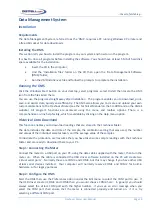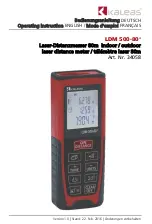
...the
art
of
distell
‐
ing...
Freshness
Meter
User
Manual
Page
16
freshness
unless
related
to
the
time
of
the
year.
It
has
been
found
that
a
better
way
of
expressing
freshness
is
to
construct
a
system
of
numerical
scales
based
upon
methods
of
objective
sensory
assessment
by
a
trained
taste
panel.
Such
a
system
is
better
because
it
is
directly
related
to
eating
quality
rather
than
depending
on
knowledge
of
the
storage
conditions.
Often
the
fish
is
allocated
to
one
of
a
few
quality
grades
based
on
definitions
in
sensory
terms.
An
example
of
this
is
the
European
Economic
Community’s
system
of
grading
fish
for
marketing
purposes.
An
extreme
form
of
this
type
is
the
public
health
inspector’s
grading
into
fit
and
unfit.
A
quality
controller
may
not
even
consciously
put
a
score
or
a
grade
to
a
batch,
but
must
accept
or
reject
it
for
the
purpose
in
mind.
In
practice
the
quality
controller
in
industry
adopts
the
most
convenient
system
for
his
purpose,
but
an
official
inspector
will
have
to
use
whatever
is
laid
down
in
the
regulations.
It
is
quite
possible
to
define
grades,
boundaries
or
acceptance/rejection
ranges
of
freshness
for
various
outlets,
etc,
in
terms
of
meter
readings
and
indeed
this
is
a
good
way
of
using
the
instrument.
However,
until
the
user
is
familiar
with
the
instrument,
it
is
best
to
employ
it
in
parallel
with
the
accustomed
method
of
assessing
freshness.
After
some
experience,
the
relationship
between
the
quality
levels
the
user
is
familiar
with
and
the
meter
readings
can
be
established.
Nevertheless,
the
meter
can
be
used
by
an
unskilled
operator
after
very
little
instruction.
As
a
guide
to
the
values
that
can
be
expected
from
some
species
of
interest
to
European
Fish
Processors,
average
readings
for
different
levels
of
freshness
are
shown
in
the
set
of
organoleptic
charts
in
the
section.
These
results
were
obtained
by
Torry
Research
Station
at
their
laboratories
in
Aberdeen
and
Hull,
and
at
various
fishing
ports
in
the
UK.
The
sensory
scores
are
based
on
the
scales
used
at
Torry
Research
Station,
and
have
been
described
in
their
publications.
These
scales
were
interpreted
as
follows:
•
Perfectly
fresh
fish
is
given
a
score
of
10.
•
Good
quality
fish
has
a
score
of
6
or
more.
•
Below
a
score
of
4,
the
fish
are
considered
unfit
to
eat.
These
freshness
scores
are
only
a
rough
guide.
Users
are
strongly
advised
to
obtain
equivalent
levels
from
scores
given
by
their
own
trained
panel,
as
the
scores
may
be
based
upon
different
criteria,
or
obtained
under
different
conditions,
from
those
obtained
by
Torry
Research
Station
and
Distell.
For
comparison,
the
approximate
number
of
days
of
storage
in
ice
which
would
cause
the
fish
to
reach
a
given
freshness
score
is
also
included
in
the
charts.
An
explanation
of
the
different
columns
of
meter
readings
is
given
in
the
next
section.
The
examples
given
are
typical
demersal
fish.
The
situation
with
fish
of
high
and
variable
fat
content
is
rather
more
complex,
and
the
relationships
between
the
meter
readings
and
sensory
scores
have
not
yet
been
made
clear.
However,
extensive
work
carried
out
by
the
staff
of
Torry
Research
Station
with
herring
has
established
that
the
manner
in
which
meter
readings
vary
with
time
of
storage
in
ice
is
very
dependent
on:
a.
The
fat
content
of
the
fish.
b.
Whether
or
not
it
is
iced
immediately
after
catching.
c.
The
extent
to
which
it
is
subjected
to
handling.
The
organoleptic
charts
show
the
approximate
age
in
ice
corresponding
to
given
meter
readings
for
boxed
herring
of
various
fat
contents.
The
age
‐
in
‐
ice
is
valid
only
for
fish
which
has
been
boxed
and
iced
immediately
after
catching.
Delayed
icing
always
gives
rise
to
lower
meter
readings
during
subsequent
storage
in
ice
compared
with
those
shown
in
the
chart.
















































